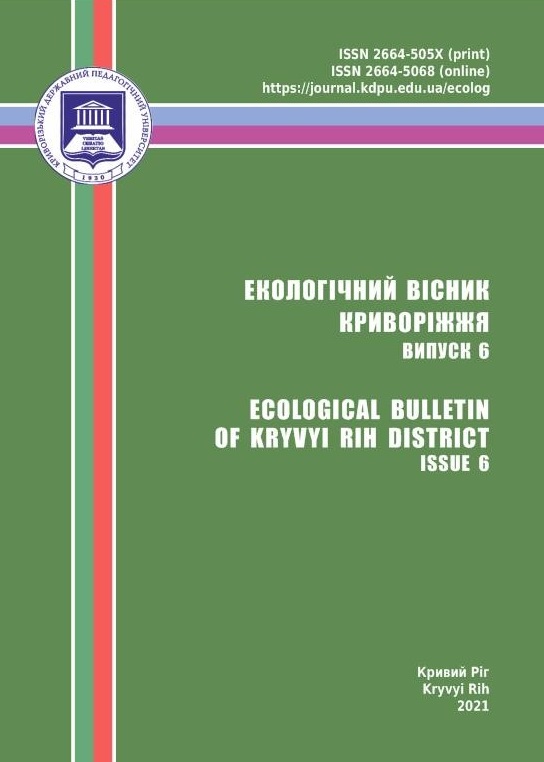ECOLOGICAL STRUCTURE OF PLANT GROUPS OF KRYVYI RIH URBAN INDUSTRIAL COMPLEX
DOI:
https://doi.org/10.31812/eco-bulletin-krd.v6i0.4564Keywords:
plant groups, industrial pollution, mining and metallurgical region, resistanceAbstract
With the help of ecological and conomorphic analysis of vegetation
using the data “Ecoflora of Ukraine” according to the principles developed
by O. L. Belgard (1960) found that in the plant groups of the Kryvyi Rih
urban complex there are 74 species belonging to 63 genera and 22 families. The
most common members of such families as Asteraceae, Fabaceae, Brassic´aceae,
Poaceae, Rosaceae, Apiaceae, Plantaginaceae, Salicaceae.
The base of plant groups of the Kryvyi Rih urban-industrial complex is
created by ruderants (51.27% of the total number of species) and stepants
(21.61%). In addition, among the life forms according to the classification
K. Raunkier (1934) is dominated by hemicryptophytes (50% of the total
number of species) and therophytes (25.9%). In terms of preferences for water
regime, the most numerous are xeromesophytes (53% of the total number of
plants) and mesoxerophytes (29.4%). The groups are dominated by heliophytes
(55.0%) and mesotrophs (60.6%).
Ecological characteristics of the vegetation of research areas according to the
system of ecomorphs O. L. Belgard (1950) found that the dominant position
among coenomorphs belongs to ruderants (51.27% of the total number of
species) and steppes (21.61%). The sites in the Metallurgical District are
dominated by ruderants and steppes.
The climamorphic spectrum showed a quantitative predominance in the
composition of plant groups of hemicryptophytes (50% of the total number of
species) and therophytes (25.9%). In general, all areas are dominated by plants
that die at the beginning of the unfavorable period to ground level or survive
it exclusively in the form of seeds. This is one of the effective physiological
mechanisms of preservation and increase in the number of species composition
in the areas.
Analysis of hygromorphic spectra revealed the dominant role of transitional
forms from xerophytes to mesophytes. Xeromesophytes represent almost 53%
of the total number of plants, and mesoxerophytes account for 29.4%. There
are no xerophytes in plot 3.
The number of heliophytes (55.0% of the total number of species) is the
largest among heliomorphs of all research sites. Among tropomorphs, the most
numerous are mesotrophs (60.6% of the total number of species), megatrophs
and oligotrophs are represented in equal numbers, namely 19%. Thus, the most
numerous ecomorphs in the phytocenoses of research sites with different levels
of pollution are ruderants, hemicryptophytes, xeromesophytes, heliophytes
and mesotrophs. Stepants, solvants, therophytes, mesophytes, megatrophs and
oligotrophs have a stable presence.
Downloads
Metrics
References
2. Dobrovolskyi, Y. A. (1988). Voprosu fytoyndykatsyy y monytorynh zahriaznenyia atmosfernoho vozdukha s pomoshchiu drevesnukh rastenyi [Phytoindication issues and monitoring of air pollution with the help of woody plants]. Monitoringovyie issledovaniya lesnyih ekosistem stepnoy zonyi, ih ohrana i ratsionalnoe ispolzovanie [Monitoring studies of forest ecosystems of the steppe zone, their protection and rational use], 62–68. (in Russian).
3. Hlukhov, O. Z. (2008). Indykatsiia stanu tekhnohennoho seredovyshcha za morfolohichnoiu minlyvistiu roslyn [An indication of the state of technogenic environment is after morphological changeability of plants]. Promyslova botanika [Industrial botany], 8, 3–11. (in Ukrainian).
4. Hryshko, V. M., Syshchykov, D. V., & Piskova, O. M. (2012). Vazhki metaly: nadkhodzhennia v grunty, translokatsiia u roslynakh ta ekolohichna nebezpeka [Heavy metals: entering soils, translocation in plants and ecological danger]. Donetsk: Donbas. (in Ukrainian).
5. Hryshko, V. M. (2012). Vmist riznykh za rukhomistiu form tsynku v gruntakh urbanizovanykh terytorii [A table of contents of different after mobile forms of zinc is in soils of the urbanized territories]. Biolohichni systemy [Biological system], 4 (2), 149–153. (in Ukrainian).
6. Kazakov, V. L., Paranko, I. S., Smetana, M. H., Shypunova, V. O., Kotsiuruba, V. V., & Kalinichenko, O. O. (2005). Pryrodnycha heohrafiia Kryvbasu. [Natural geography of Kryvbas]. Kryvyi Rih: KDPU. (in Ukrainian).
7. Komarova, I. O. (2015). Osoblyvosti funktsionuvannia roslynnoho orhanizmu v urbotekhnohennii ekosystemi (analiz stanu problemy) [Features of functioning of vegetable organism are in urbotekhnogenniy ekosistemi (analysis of the state of problem)]. Pytannia bioindykatsii ta ekolohii [Issues of bioindication and ecology], 20 (2), 18–29. (in Ukrainian).
8. Silich, I. O. (2015). Buferni vlastyvosti gruntiv yak pokaznyk zabrudnennia vazhkymy metalamy edafotopiv Kryvorizkoi urboekosystemy [Buffer properties of soils as an indicator of heavy metal pollution of edaphotopes of the Kryvyi Rih urban ecosystem]. Ahroekolohichnyi zhurnal [Agroecological Journal], 4, 65–69. (in Ukrainian).
9. Silich, I. O. (2013). Vmist vazhkykh metaliv u rekreatsiinykh ta promyslovykh zonakh Kryvorizhzhia [The content of mobile forms of heavy metals in recreation edaphotops and industrial areas of Ecological Bulletin of Kryvyi Rih District. 2021. Issue 6 117
Kryvorizhya]. Gruntoznavstvo [Soil Science], 14 (3–4), 35–42. (in Ukrainian).
10. Yevtushenko, E. O., Shanda, V. I., Savosko, V. M., Malenko, Ya. V., Voroshylova, N. V., Hnilusha, N. V., Kachynska, V. V., Kobriushko, O. O., Komarova, I. O., Pozdnii, Ye. V., & Marchenko, S. O. (2017). Struktura ta rozvytok kulturfitotsenoziv Kryvorizhzhia: monohrafiia [Structure and development of cultural phytocenoses of Kryvyi Rih: monograph]. E. O. Yevtushenko, V. M. Savoskо (ed.). Kryvyi Rih: Dionat. (in Ukrainian).






